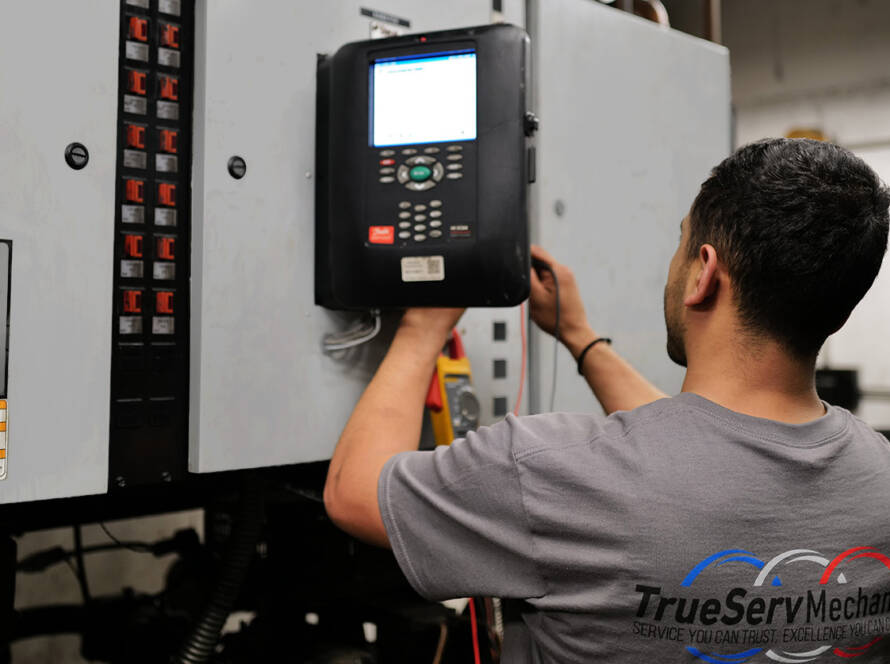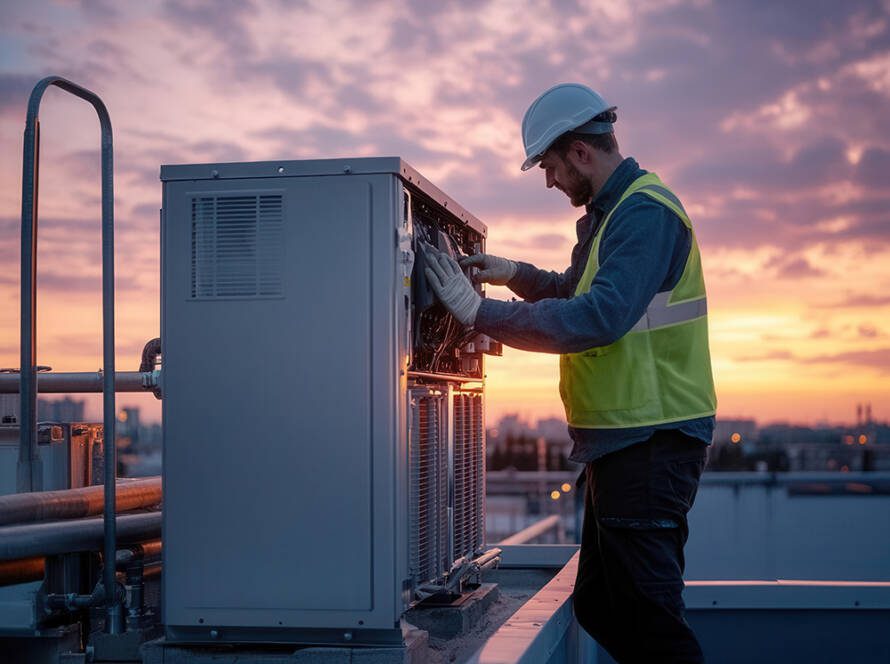Why Commercial Refrigeration isn’t “Set It and Forget It”
Too often, business owners assume that once their walk-in cooler or merchandiser display is installed, it’ll just run quietly in the background. But just like an HVAC system or company vehicle fleet, refrigeration equipment requires ongoing attention to operate efficiently and avoid surprise breakdowns.
Failing to maintain or properly repair refrigeration systems can lead to:
- Spoiled inventory
- Higher energy bills
- Unsafe food temperatures (and potential code violations)
- Unexpected equipment replacement costs
Each of these risks is magnified in grocery stores, supermarkets, and c-stores—especially in warmer climates or high-traffic locations.
Grocery Store Refrigeration Systems: Built for Volume, But Not Immune to Problems
A grocery store refrigeration system is typically a complex network of interconnected equipment: walk-in coolers, reach-in freezers, open-air merchandisers, under-counter fridges, and back-of-house storage units. These systems often run 24/7, meaning any inefficiency or undetected issue can drive up energy use and compromise food safety quickly.
Top challenges grocery stores face:
- Leaks in refrigerant lines
- Faulty thermostats or temperature sensors
- Compressor wear and tear
- Door seal failures leading to temperature loss
- Clogged drains and coil freezing
Regular checkups from a commercial refrigeration technician can help detect these issues early, before they turn into costly shutdowns. Plus, newer high-efficiency systems and refrigerants can be integrated into existing setups during upgrades to lower energy costs.
Supermarket Refrigeration: Energy Efficiency is the Name of the Game
In supermarkets, refrigeration accounts for a huge portion of monthly utility costs—often more than 50% of total energy use. This makes supermarket refrigeration one of the most strategic areas for improvement when it comes to bottom-line savings.
Smart strategies for supermarket refrigeration:
- Install night blinds on open cases to conserve energy during closed hours
- Use variable-speed compressors and EC motors to reduce power consumption
- Schedule quarterly maintenance to clean condenser coils and check airflow
- Upgrade to remote monitoring systems for real-time temperature alerts
Because supermarkets usually have a mix of walk-in cold storage and customer-facing refrigerated displays, it’s essential to work with a refrigeration partner who understands traffic flow, display layout, and regulatory requirements for food storage.
Tip: Want to go greener? New low-GWP refrigerants like CO₂ or R-448A are being phased in across the country to meet EPA standards—and technicians trained in alternative refrigerants can help you make the switch safely.
Convenience Store Refrigeration: Small Footprint, High Expectations
Convenience store refrigeration may be compact, but the expectations are just as high. Customers want consistently cold beverages, snacks, ice, and dairy products—day or night. But small-format stores often have limited room for backup equipment, making reliability even more critical.
Common refrigeration units in C-stores:
- Single-door upright coolers
- Grab-and-go open air merchandisers
- Countertop beverage chillers
- Ice machines and under-counter freezers
Because of their smaller footprint, C-store systems can be especially sensitive to ambient heat, dirty filters, or door seal issues. Even a small change in airflow can force these systems to work harder—leading to burnout or equipment failure.
What C-store owners should do:
- Schedule routine checks on door gaskets and thermostats
- Keep condenser coils clean (especially in dusty or high-traffic areas)
- Replace lighting with LEDs to reduce internal heat loads
- Monitor for early signs of failure like unusual noise or inconsistent cooling
Installation Quality Makes All the Difference
No matter your store format, proper refrigeration system installation is critical. Cutting corners during the install—like incorrect refrigerant charging, poor airflow clearance, or mismatched system sizing—can set you up for years of inefficient performance and early breakdowns.
When planning a new store, expansion, or equipment upgrade, work with licensed technicians who:
- Understand your store’s layout and product flow
- Can recommend the right equipment brands and models for your needs
- Ensure full compliance with health, building, and refrigerant codes
- Provide documented commissioning and system testing
Preventive Maintenance: The Insurance Policy You Actually Use
Routine maintenance might feel like just another expense, but it’s often the key to avoiding major emergencies. Most issues that cause refrigeration system failure—like compressor burnout or coil freezing—start small and become catastrophic over time.
What a preventive maintenance visit usually includes:
- Checking refrigerant levels and system pressure
- Cleaning condenser and evaporator coils
- Inspecting electrical connections
- Testing thermostats and controls
- Verifying door gaskets and insulation
- Checking for unusual vibrations or noises
For multi-location stores, setting a maintenance plan across all sites creates consistency, reduces downtime, and helps predict capital expenditures.
Signs It’s Time to Upgrade Your System
Even with great maintenance, refrigeration systems have a finite lifespan. If your store is relying on units that are over 10–15 years old, you could be losing money every day due to inefficiency—even if the system hasn’t failed yet.
Red flags that it might be time for an upgrade:
- Inconsistent temperatures or product spoilage
- Frequent service calls for the same unit
- Rising energy bills with no clear cause
- Refrigerants being phased out (like R-22)
- Loud or unusual system noise
Choosing the Right Refrigeration Partner
Not all commercial refrigeration companies are the same. Look for a provider that understands the demands of retail environments—especially grocery, supermarket, and convenience store refrigeration, and a company like TrueServ Mechanical that offers:
- 24/7 emergency support
- Preventive maintenance plans
- Help with EPA and energy compliance
- Expertise in new system installation and retrofits
- Service across all your business locations
Whether you’re running a single location or managing dozens, the right partner helps keep your refrigeration systems reliable, compliant, and cost-effective.
Final Thought
A failing refrigeration unit doesn’t just risk your inventory—it risks your reputation. By investing in quality installation, regular maintenance, and system upgrades when needed, grocery stores, supermarkets, and convenience stores can stay cool, compliant, and customer-ready year-round.
If you’re planning a new store, expanding operations, or want to optimize your current refrigeration setup, contact our TrueServ Mechanical team. Reach out today to schedule a system evaluation—and stay ahead of the next breakdown.


